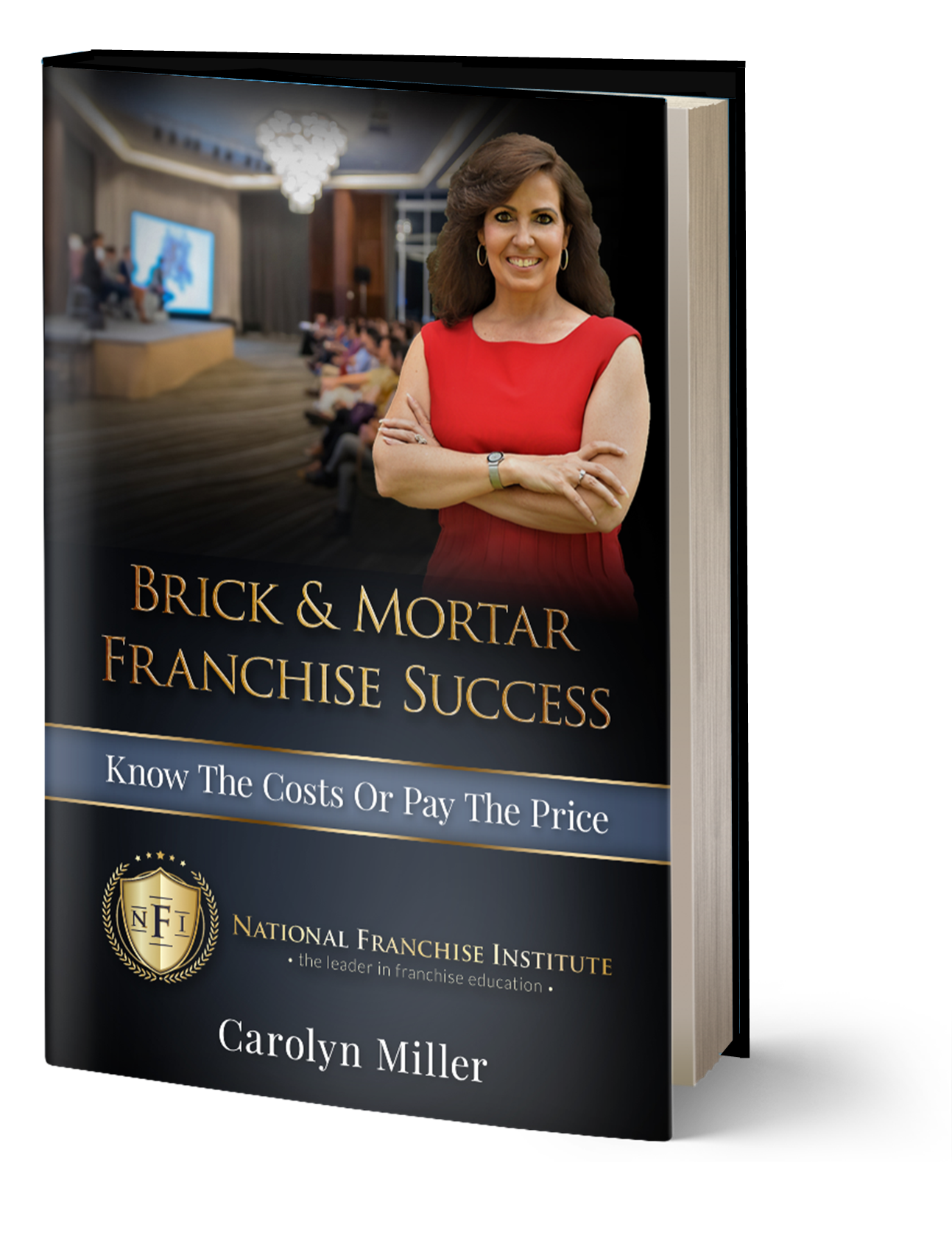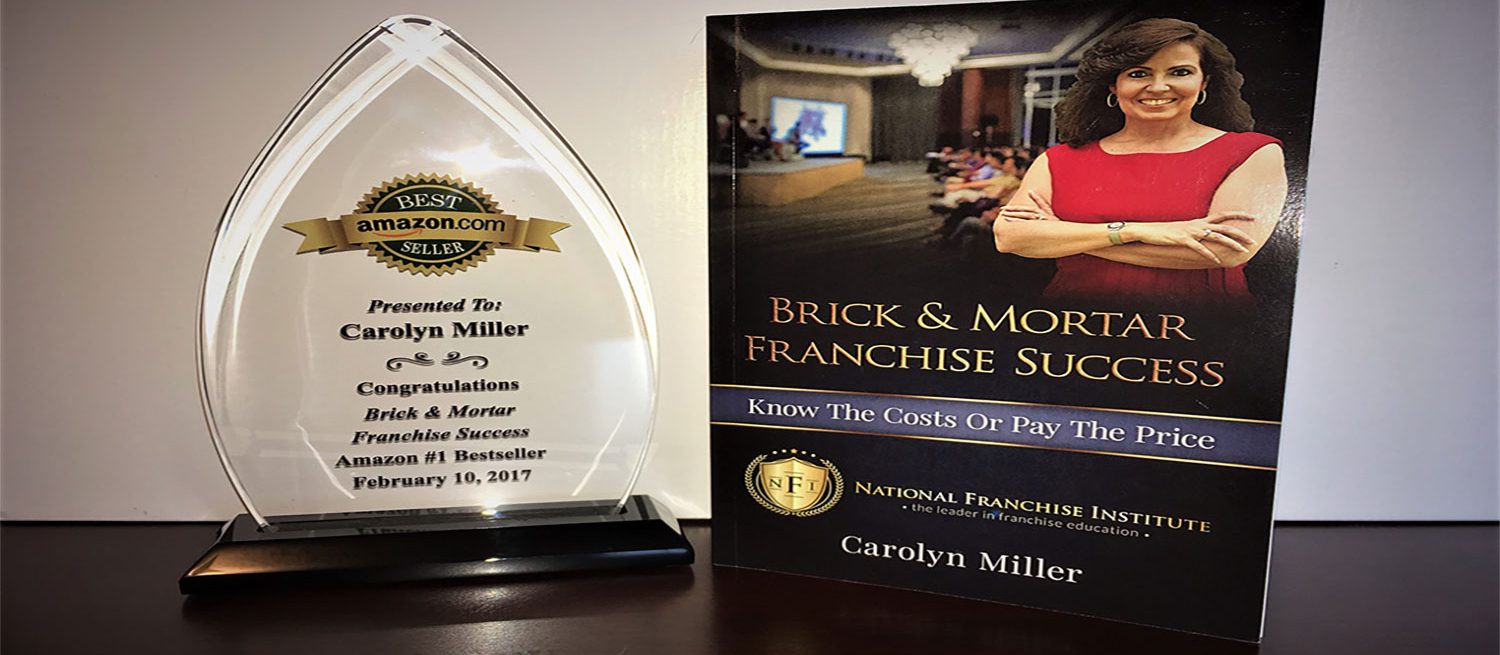MRM Talking With: Carolyn Miller, Founder of the National Franchise Institute
10 Min Read By MRM Staff
In this edition of MRM Talking With, Carolyn Miller, founder of the National Franchise Institute and author of “Brick & Mortar Franchise Success: Know The Costs or Pay The Price,” discusses the complexities of location selection and how franchises are evolving. According to Miller, the purpose of the book is to take the guesswork out of the entire development process so franchisees and independent restaurateurs know exactly what it takes to get new locations open in the least amount of time, for the best overall price and, more important than anything else, without making costly mistakes in the process.
Miller began her franchise career in 1984 at McDonald’s headquarters in Oak Brook, IL where she worked for more than 14 years. During six of those years, she orchestrated the development efforts of 40 McDonald’s regions in opening close to 1,000 “McDonald’s in Wal-Mart” locations in the U.S. and Canada. In 1998, when McDonald’s infused capital into Chipotle Mexican Grill, Miller moved to Denver and helped create the real estate infrastructure for Chipotle’s national expansion. Over the years, she has also worked in corporate and on the franchise side of Red Robin, CiCi’s Pizza, and Carl’s Jr./Hardee’s. Miller founded the National Franchise Institute in 2015.
What do you find compelling about the franchise environment?

Franchising is fascinating because it continues to evolve and keep pace with changing consumer demands. When most people think of franchising, McDonald’s and other restaurant concepts usually come to mind first. But franchising extends well beyond restaurants and includes concepts – like doggie daycare facilities, funeral homes, weight loss centers, home health care concepts, orthodontic and vision centers, and even a crime scene clean-up concept – which many people are surprised to learn are franchise concepts.
As consumer demands change, it’s exciting to know that franchising will be just around the corner – ready, willing and able to step to the plate.
How are franchises changing and how do you see this evolving in the future?
I see changes – or should I say evolutions – in a couple of areas.
Although there has been a shift toward signing multi-unit Franchise Agreements with experienced franchisees who simply add additional brands under their franchise ownership umbrella, inevitably growth of the franchise industry will continue to depend on first-time franchisees. There are already a lot of franchise concepts on the market and newly-formed brands are hitting the streets almost daily. Millennials are coming into their own and represent the next wave of franchisees – and franchisors – who will bring their own creativity and execution standards to the franchise industry.
Food concepts will continue to be a popular category. When the “better burger” category originally emerged a lot of people thought it would burn itself out pretty quickly because there are only so many things you can do with a burger. Fast forward a decade or so and there are now a number of distinctly different and successful burger concepts across the U.S. ‘Pizza wars’ and healthy food options signaled the next wave of restaurant concepts. Breweries are another food-related category that continue to attract attention.
As Millennials vote with their dining-out dollars, they gravitate toward casual and fast casual concepts that offer healthier and better-tasting food at a higher price point. Inevitably, franchising will pivot and evolve in order to rise to the occasion – whether through healthier offerings at existing concepts or by welcoming new brands to the franchise industry.
“Why do you feel the phrase, ‘Location, Location, Location,’ has become such a part of our culture?
‘Location, Location, Location’ is the Holy Grail of site selection because it affects not only the current sale or lease transaction but also the long-term success and profitability of the business that operates within the space for years to come.
Where franchisees put their new location matters – a lot! In the grand scheme of things, a franchisee can do every other thing ‘right’ but if the location is wrong, they can still fail. With so much on the line, finding the right location is one of the most important decisions of any new business owner, whether franchise or independent.
In every town there is one location that seems well situated, but always turns from one franchise to another with none sticking long term. Why do you think that happens and what can a potential franchisee learn from that?
In my home town in suburban Chicago, we also had one of these locations but it was the revolving door of independent restaurants vs. franchised concepts. Every business owner would love to think that they are going to be the exception but if there’s a history of opened/closed restaurants at the same location, any franchisee would do well to move forward cautiously and really step up their due diligence efforts.
While it may not be possible to speak with too many of the older former occupants of the shuttered location, it should be possible to talk to the most recent owner or tenant. Keep in mind, of course, that they may not be as candid as you really want or need them to be so the onus is on the restaurateur (as the prospective new tenant) to ask the right questions. Examples might include:
- Is the space too large? Even if the per-square-foot price is low, it costs money to furnish, maintain, heat and cool the space. Those extra dollars can really add up.
- Is the base rent too high? Are real estate taxes too high (and climbing)?
- Is parking a problem? Keep in mind that it’s not just the number of spaces. There may be a lot of parking spaces but if neighboring businesses’ busy times are roughly the same as your busy times, everyone’s customers will be competing for the same spaces at the same time of day while the parking lot remains relatively empty for the rest of the day.
- Ingress/egress (can customers easily get into and out of the location easily?)
- If there isn’t a traffic signal, how many lanes of traffic will exiting customers need to cross over in order to make a left-hand turn?
- Because of a median, are they only allowed to make a right-hand turn?
- Once they make the right-turn-only, how much farther will they have to travel before they can eventually get turned around to head in the direction they need to go?
- Is the landlord’s lease too one-sided?
One example might be that the landlord’s lease is written so that current tenants pick up the triple net charges for any vacant spaces vs. just their own pro-rata share.
Another example is that the building itself may be older so repairs and maintenance issues will definitely come up. If the lease specifies that tenants pay the full amount for anything that needs to be repaired or replaced and there is no cap per occurrence, a single replacement item could be the financial straw that breaks the camel’s back. Think about commercial HVAC units where the health department will shut a restaurant down if the HVAC goes out. The cost for one 10-ton HVAC unit can cost between $15,000 and $17,000. Then add the labor cost to remove the old and install the new which is extra. There are also geographic differences that drive costs higher (like Title 24 in California which requires certain energy efficiency standards, dehumidification requirements for Florida and Texas, and structural requirements within seismic zones are some examples). If the repair is an emergency, the price will likely be higher. Consider also the lost sales that your business will not be able to ring in while your restaurant is closed during the repair/replacement. With a price tag of more than $20,000 for a single incident, a restaurateur could easily fail – and the space then becomes available for the next restaurateur to take a crack at it.
Could the landlord be the problem? If it’s a leased space (vs. a purchase), the landlord is one of the common denominators in every tenant relationship that has occurred at that location so don’t be too quick to dismiss its significance. Dig deep and ask questions.
What makes a good location for different food businesses?
Franchising will pivot and evolve in order to rise to the occasion–whether through healthier offerings at existing concepts or by welcoming new brands to the industry.
Customers! All kidding aside, if you have a gorgeous restaurant with the best food in town but it isn’t located where customers are, its chances for success are definitely lower.
There is a tendency to think that if you are the only restaurant in a particular area that people will naturally come to you because you are the only game in town. The reality is that if you are one of several restaurants in close proximity to each other, the area becomes a draw that will bring in many more customers because of the variety of food offerings.
The majority of food businesses are impulse purchases. When meal or snack time rolls around and stomachs start grumbling, two things can tip the scales toward success: visibility and ease of access.
As soon as hunger pangs hit, visibility is key. If your restaurant can’t be seen, hungry people go elsewhere.
From an ease of access standpoint, think about the morning commute where a coffee sign might create an involuntary need for a cup-o-joe. If the coffee shop is on the ‘going to work’ side of the street, cars have been known to drive themselves straight to the order window! A driver who is pressed for time but who can easily drive up, order and pay, and easily get right back on the road headed toward work is a much easier customer to attract than a coffee shop that is situated on the opposite side of the street where too much cross-traffic maneuvering would be required.
If a franchisee happens to have a sub-par location, what are things they can do to combat it?
First and foremost I would suggest meeting with the landlord to see if better (or additional) signage can be added to increase awareness and your visibility.
By enlisting the help of employees that you’re already paying, you can increase your customer counts without any additional expense. Which of your employees are ‘killing it’ on social media? Since the success of your business is directly tied to their paychecks, to a certain degree they are inherently already incentivized. Compliments and sincere appreciation go a long way – probably farther than many business owners realize.
Once a location is open, it really comes down to marketing. While I’m not a marketing expert, it goes without saying that the best thing a franchisee can do is get started early! When any business owner sees that sales are below where they need to be to make a profit, the reality is that they will never have more money than they do right now to take action. The more time that passes without stopping the decline means there is less money coming in the door to pay for ‘anything’. Once hard costs like rent, utilities, and payroll are paid, the likelihood that funds will be left over to pay for marketing efforts is slim. Fear can easily take hold and compound the problem. Look for heroes on your current team and let them work their magic.
How do you define “Location Intelligence?”
A lot of people have heard the term Site Selection Criteria which tells new franchisees what to look for in a given area — location intelligence identifies where they should be looking in the first place.
Part of Site Selection Criteria defines population counts, targeted age ranges within a demographic area, and median household income. Site selection criteria also deals with the physical attributes of a particular space – things like price per square foot, the size of the space and its dimensions, ingress/egress (i.e., how customers get into and out of the center), traffic counts, the availability of signage and parking, and anchor tenants within the center.
Many new franchisees focus so much on the lease rate that they often sign leases without confirming if the trade area will support their business. Location intelligence digs into behind-the-scenes details to determine if enough actual customers (not just ‘people’) are in a particular trade area. It also pays attention to competitive intelligence since there may already be too many other similar-type businesses that will essentially be competing for the same dollars. In the grand scheme of things, an extremely low lease rate will be of little consolation to a franchisee if there aren’t enough sales to pay the lower rent. It’s better to find the best space at the right price. Location intelligence is one of the tools that helps increase the likelihood of success before a lease is signed.
What are common mistakes prospective franchisees make regarding locations?
DIY
A ‘good deal’
Convenience
Newer franchisees are often so excited to get started that they inadvertently take a ready-FIRE!-aim approach in finding a location for their business. One example is that instead of enlisting the help of a commercial real estate professional, they drive around town looking for available space on their own. When they find space that is a ‘good deal’ or is conveniently located near their home or their child’s school or daycare center, they sign the lease and then start the critical due diligence tasks.
What they quickly learn – which often comes at a high price – is that landlord leases are written by landlords or their attorneys which means the documents are landlord-friendly, not tenant-friendly. This immediately gives the landlord an unfair advantage over the franchisee who may not understand the all-in costs associated with a commercial lease or which items within the lease are negotiable (and to what extent). A lot of new business owners believe that leases are ‘take it or leave it’ documents that are absolutely not negotiable. As a result, they leave a lot of money on the table.
When it comes to construction project management, architecture and construction, many franchisees get a crash course in all that is involved (and how long it actually takes) to get their doors open for business. Local zoning codes dictate a lot of details about leased spaces (i.e., what types of businesses can actually operate within the space, parking, utility size requirements, and proximity restrictions based on other businesses in the area are some examples). Zoning requirements can easily have tens of thousands of dollars’ worth of impact on a restaurant space and once a lease is signed, the franchisee’s leverage with the landlord vanishes.
Putting all the pieces together for a franchise location can seem daunting so why do you feel it’s a goal for so many people?
It can definitely be a daunting task but statistics show that franchising is one of the most successful business models in the world.
Business ownership is one of the great American dreams. Entrepreneurial spirits can get giddy with excitement at the thought of starting their own business. The excitement usually starts to wane when tasks like creating the entire infrastructure, establishing supplier networks and negotiating prices, and putting together a detailed and all-inclusive training program begin to feel overwhelming.
Rather than taking a chance on a completely new business venture, people opt for the franchise model because it’s a proven system that will generate revenues faster, for less money, and for a lot less time than if they were to create an independent concept on their own. Because franchising is highly regulated and protects franchisees, it is also safer than trying to start a business from scratch.
What is the origin of the National Franchise Institute?
The National Franchise Institute was originally founded to help franchisees get new locations open in the least amount of time, for the best overall price, and without making costly mistakes in the process.
There are companies and consultants that focus on marketing, sales, and operations but no one was focusing on the development side of things (which is real estate, architecture, construction, and real estate legal). As a result, franchisees were making tens of thousands of dollars’ worth of mistakes as they leased space and built new locations. The unfortunate part is that many of the mistakes they were making were preventable – they just didn’t know what they didn’t know.
Larger franchise brands usually have the infrastructure and the financial resources to help franchisees get new locations open. New and emerging franchise brands, on the other hand, have fewer resources so franchisees find themselves learning as they go.
‘Brick & Mortar Franchise Success’ is a fast-track program that gives franchisees the information and the go-to resources they need to successfully get their doors open for business without pulling time and resources away from the franchisor’s corporate team. Rather than being taught by consultants, our programs are taught by licensed attorneys, CPAs and tax professionals, licensed architects and engineers, licensed general contractors and other business and franchise experts so we are able to offer not only the educational information but also the professional resources that franchisees need to be successful.
In addition to the Brick & Mortar Franchise Success program, the National Franchise Institute’s ‘Growth Strategies’ program also helps independent entrepreneurs determine if franchising is the best growth strategy for a concept they have created.
Miller’s “Brick & Mortar Franchise Success: Know The Costs or Pay The Price,” can be purchased as Kindle or paperback on Amazon.

